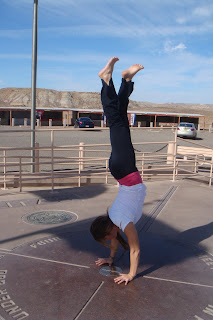
Ahh running. The simplest discipline in triathlon, after all, it's something that we have been doing naturally since we were kids right?? well, not exactly.... There is as much, if not more, technique involved in running as there is in swimming and biking. We as athletes often neglect the necessary drills that will make us better runners because "we already know how to run." The simple fact is that your technique, not your fitness level, is likely your main run inhibitor!! Now I can provide you with a
very in depth analysis of your run gait, if you happen to be in the Denver/Golden area for a very reasonable cost, but if that does not include you then here are some quick tips to get you started. First and foremost, and possibly the most difficult concept to grasp, running is NOT a muscularly driven exercises! It is a GRAVITY driven exercise! If you want to go faster, pushing off of the ground harder will accomplish little else than pushing you upward not forward. Instead, focus on increasing your forward lean. This combined with a faster leg turnover (90+ strikes per foot per minute) will result in moving faster. Grasping this concept is the first step, here are a few other tips from the top down.
Breathing: It is amazing how focusing on the tiny little muscles of your jaw can effect you run. By relaxing the jaw we allow for a great deal of ease while breathing. One of the main focuses in ANY yoga practice should be that of Prana, or breath. Yoga teaches us to maintain an even breathing pattern even in the most uncomforatable positions.
Shoulders: Should be relaxed, not touching the earlobes!
Arms: Elbows maintain just over a 90 degree angle. Fingers are relaxed. It is OK to utilize your arms while running. The appropriate amount of arm movement brings the knuckle of the pinkie finger from the nipple to the bottom of the rib cage on the mid-axillary line.
Waist: The bodies rotation should actually be accruing just above the hips. I know this seems odd, but trust me more energy can be drawn from this place at latter stages in a race. (Think axis of rotation in the water while up right.)
Legs: We already know that we shouldn't be using those tree truck quads that we have developed from endless hours of cycling. So what role are they playing? The main muscle groups being utilized in running are hamstrings, gastrocnemius (ball of calf), and the hip flexor and soas (OK, not necessarily a muscle of the leg). By pulling the heel of the foot to the buttock we create an almost "figure four" position with our legs from a side angle. (quick do it in the mirror, i can wait) OK, as that leg returns to the earth the opposite leg begins to repeat the posture. The gastroc absorbs the majority of the impact and like a spring returns the initial leg back to the figure four.
Feet: Your feet should be striking as close to under your hips as possible. The further out in front of you they are, the more of a brake they are creating. Impact should occur on the ball to mid foot, not the heel. Heel striking wreaks havoc on the ankles and knees as the shock of impact is being absorbed in the joint rather than the muscle and connective tissue. Toe running is not optimal as it requires much more energy from the lower legs. Sprinters do this because they only have to cover a short distance.
Now remember to make a cool face when you get your picture taken at the finish line!



